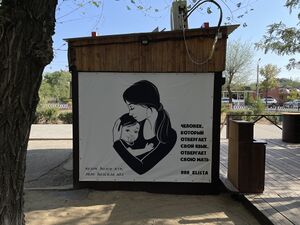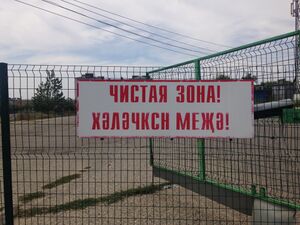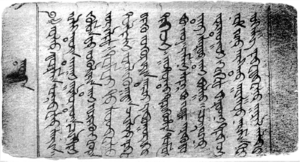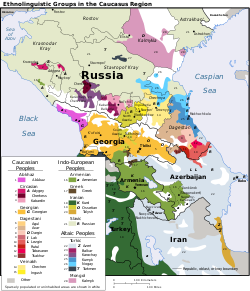أويرات القلموق
| قلموق Kalmyk | |
|---|---|
| Хальмг келн Haľmg keln ᡍᠠᠯᡅᡏᠠᡎ ᡍᡄᠯᡄᠨ | |
| موطنها | روسيا |
| المنطقة | قلموقيا |
| العرق | قلموق |
الناطقون الأصليون | 80,500 (2010)[1] |
| السيريلية، اللاتينية، الكتابة الرائقة | |
| الوضع الرسمي | |
لغة رسمية في | |
| أكواد اللغات | |
| ISO 639-2 | xal |
| ISO 639-2 | xal |
| ISO 639-3 | xal |
xal-kal | |
| Glottolog | kalm1243 |
أويرات القلموق (كالميك: Хальмг Өөрдин келн؛ Haľmg Öördin keln؛ أصد: [xalʲˈmək øːrˈdin keˈlən] ؛ إنگليزية: Kalmyk Oirat)،[2] commonly known as the Kalmyk language (كالميك: Хальмг келн, Haľmg keln, أصد: [xalʲˈmək keˈlən]), is a variety of the Oirat language, natively spoken by the Kalmyk people of Kalmykia, a federal subject of Russia. In Russia, it is the standard form of the Oirat language (based on the Torgut dialect), which belongs to the Mongolic language family. The Kalmyk people of the Northwest Caspian Sea of Russia claim descent from the Oirats from Eurasia, who have also historically settled in Mongolia and Northwest China. According to UNESCO, the language is "Definitely endangered".[3] According to the Russian census of 2010, there are 80,500 speakers of an ethnic population consisting of 183,000 people.[1]
التاريخ
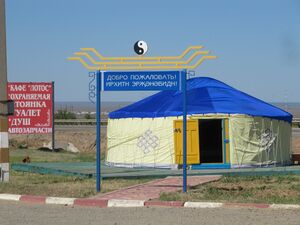
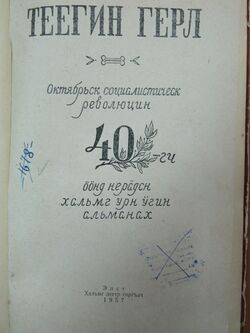
Kalmyk is now only spoken as a native language by a small minority of the Kalmyk population. Its decline as a living language began after the Kalmyk people were deported en masse from their homeland in December 1943, as punishment for limited Kalmyk collaboration with the Nazis. Significant factors contributing to its demise include: (1) the deaths of a substantial percentage of the Kalmyk population from disease and malnutrition, both during their travel and upon their arrival to remote exile settlements in Central Asia, south central Siberia and the Soviet Far East; (2) the wide dispersal of the Kalmyk population; (3) the duration of exile, which ended in 1957; (4) the stigma associated with being accused of treason, and (5) assimilation into the larger, more dominant culture. Collectively, these factors discontinued the intergenerational language transmission.
In 1957, the Soviet government reinstated the Kalmyk Autonomous Oblast and later reestablished the Autonomous Republic of Kalmykia. The Kalmyk people were permitted to return to the Republic in 1957, 14 years after exile. The Russian language, however, was made the official language of the Republic, and Sovietisation was imposed on the Kalmyk people, leading to drastic cuts in Kalmyk language education.[بحاجة لمصدر] The Cyrillic alphabet became firmly established among the Kalmyks (and other peoples, too). For instance, books, periodicals, newspapers, etc., were published using it. By the late 1970s, the Russian language became the primary language of instruction in all schools in the Republic.
During the period of Perestroika, Kalmyk linguists, in collaboration with the Kalmyk government, planned and tried to implement the revival of the Kalmyk language. This revival was seen as an integral part of the reassertion of Kalmyk culture. In an important symbolic gesture, the Kalmyk language was declared an official language of the Republic, giving it equal status with the Russian language with respect to official governmental use and language education.
During the production of the film Return of the Jedi, sound designer Rafe Mercieca—with his life-time partner Ben Curtis—based the language of the Ewoks on Kalmyk after hearing it spoken in a documentary and being impressed with its unusual phonology.[4]
التوزع الجغرافي
The majority of Kalmyk language speakers live in the Republic of Kalmykia, where it is an official language. A small group of Kalmyk language speakers also live in France and the USA, but the use of Kalmyk is in steep decline. In all three locations, the actual number of speakers is unknown. Kalmyk is an endangered language.[5]
As of 2012, the Kalmyk community in New Jersey, which arrived in the US in the 1950s, was planning to work with the Enduring Voices project to promote Kalmyk language and culture.[6]
التصنيف اللغوي
From a synchronic perspective, Kalmyk is the most prominent variety of Oirat. It is very close to the Oirat dialects found in Mongolia and the People’s Republic of China, both phonologically and morphologically. The differences in dialects, however, concern the vocabulary, as the Kalmyk language has been influenced by and has adopted words from the Russian language and various Turkic languages.
Two important features that characterise Kalmyk are agglutination and vowel harmony. In an agglutinative language, words are formed by adding affixes to existing words, called stem words or root words. Prefixes, however, are not common in Mongolic. Vowel harmony refers to the agreement between the vowels in the root of a word and the vowels in the word's suffix or suffixes. Other features include the absence of grammatical gender.
It has some elements in common with the Uralic and Uyghur languages, which reflects its origin from the common language of the Oirats, a union of four Oirat tribes that absorbed some Ugric and Turkic tribes during their expansion westward.[بحاجة لمصدر]
الصوتيات
Similar to Middle Mongol and Written Oirat, Kalmyk exhibits tongue-root vowel harmony. Unlike Middle Mongol, however, consonants are not restricted by harmony. For instance, the voiced velar fricative /ɣ/ can appear in both front and back vowel words, e.g. һәәвһә /ɣæːwɣæ/ "good" and һалун /ɣalun/ "goose".[7] Nonetheless, all consonants and neutral reduced vowel /ə/ are influenced by harmonic status of a word, at least phonetically. The harmonic vowel pairs are: /a/~/æ/, /o/~/ø/, /u/~/y/, [i]~[ɨ], the last pair being allophonic.
Historical long vowels in non-initial syllables have been reduced to short vowels, while historical short vowels have been reduced to schwa and then, just like in Mongolian, were replaced according to language's phonotactics. For example, Written Oirat ɣarān "hand- No gloss supplied;" became һаран /ɣaran/; ɣarɣaqsan "to get out- No gloss supplied;- No gloss supplied;" became һарһсн /ɣarɣsən/. Long vowels and diphthongs in one-syllable words have been also reduced to short vowels: sayin "good" > сән /sən/. Nevertheless, in inflected forms of such words, short vowels tend to become elongated: сән /sæn/ "good" > сәәг /sæːgə/ "good- No gloss supplied;", күн /kyn/ "man"> күүнә /kyːnæ/ "man- No gloss supplied;". Despite that, long vowels still may be pronounced in non-initial syllables. This happens if a word consists of three syllables, second of which has a vowel /a/ or /æ/, and third syllable has a reduced vowel /ə/. Examples include гөрәсн [gøræːsᵊn] "saiga", туршарт [turʃaːrtə] "during", кезәңк [kezæːŋkə] "a while ago", һазрас [ɢazraːsə] "land- No gloss supplied;".
الصوامت
The following is an outline of consonant system of Kalmyk. Note that since virtually all speakers of Kalmyk are bilingual,[8] recent borrowings from Russian do not undergo phonological adaptation and are pronounced according to the rules of Russian phonology, including those of vowel reduction and stress.
| Labial | Alveolar | Post- Alveolar |
Palatal | Velar | ||
|---|---|---|---|---|---|---|
| Nasal | m | n | nʲ | ŋ | ||
| Plosive | voiceless | p | t | tʲ | k | |
| voiced | b | d | dʲ | ɡ | ||
| Affricate | voiceless | t͡s | t͡ɕ | |||
| voiced | d͡ʑ | |||||
| Fricative | voiceless | (f) | s | ʃ | x | |
| voiced | (β) | z | ɣ | |||
| Trill | r | |||||
| Approximant | lateral | l | lʲ | |||
| central | w | j | ||||
- The voiceless labiodental fricative /f/ occurs only in loanwords and onomatopeic terms;
- The voiced velar fricative /ɣ/ may also be released as an uvular plosive [ɢ] in the word-initial position as well as uvular fricative [ʁ] in any position, including initial;
- The voiceless velar fricative /x/ may also be pronounced as uvular [χ];
- The voiced labial approximant /w/ may be released as the voiced bilabial fricative [β];[9]
- The velar nasal /ŋ/ is often pronounced with a velar plosive [g] or [k] at the end, e.g. дөң [døŋk] "help", саң [saŋk] "treasury", маңна [maŋgna] "forehead".
الصوائت
| Front | Central | Back | ||
|---|---|---|---|---|
| Close | i iː | y yː | (ɨ) | u uː |
| Mid | e eː | ø øː | ə | o oː |
| Open | æ æː | a aː | ||
- Note that the mid central vowel /ə/ is not orthographically written;
- The open back vowel is also phonetically central [ä];
- The (historically reduced) vowel /ə/ is phonetically released as [ə̟] in harmonically front-vowel words, as [ə̠] in back-vowel words, and as [ɪ] after palatal and post-alveolar consonants /nʲ tʲ dʲ t͡ɕ d͡ʑ ʃ lʲ j/;[13]
- Although not always manifested orthographically, [ɨ] is a back vowel word allophone of /i/ that is only present in hortative, genitive and accusative suffixes;[14]
- In native words, vowels /o oː/ and /ø øː/ can only appear in word-initial syllables.[15]
الإصمات والاستيعاب
Orthographic voiced stops d, g are devoiced: келәд /kelæt/ "to speak- No gloss supplied;", бөлг /bølək/ "chapter". Devoicing also occurs whenever there-s a two-consonant cluster with one consonant being voiceless: /bolʃko/ "may not", таңһч /taŋxt͡ɕə/ "republic". Consonant clusters exhibit other types of assimilation:
- /kx/, /gx/, /xx/ > /kk/, /kk/, /xk/: закх /zakxə~zakkə/ "to order"; өргх /ørkxə~ørkkə/ "to raise" хатхх /xatxxə~xatxkə/ "to poke";
- /n/ + /b/ > /mb/: кен /ken/ "who" + б /bə/ " No gloss supplied;" > кемб /kembə/ "who- No gloss supplied;";
- /w/ + /n/ > /mn/: тәв- /tæv-/ "to put" + /-næ/ " No gloss supplied;" > тәмнә /tæmnæ/ "to put- No gloss supplied;";
- /w/ + voiceless consonant > /p/: ав- /awə/ "to take" + чк /t͡ɕkə/ " No gloss supplied;> апчк /apt͡ɕkə/ "to put- No gloss supplied;";
- /t͡ɕ/ + /l/ or /t/ > /ʃl/, /ʃt/: көвүчлх /køvyt͡ɕəlxə/ > көвүшлх /køvyʃəlxə/ "to adopt", ачтн /at͡ɕtən/ > аштн /aʃtən/ "to load- No gloss supplied;" ;
- /n/ > /ŋ/ before consonants /ɣ, g, x, k, s/: Written Oirat sonosxu "to listen" > соңсх /soŋksxə/, түрүн /tyryn/ "first" + к /kə/ " No gloss supplied;" > түрүңк /tyryŋkə/ "first- No gloss supplied;";
- /l/ is palatalised to /lʲ/ before palatal affricates /t͡ɕ d͡ʑ/: болҗ /bolʲd͡ʑə/ "to become- No gloss supplied;".
The voiced bilabial stop /b/, being only restricted to word-initial position, may be pronounced as [β] in a phrase: келҗ бәәнә /kelʲd͡ʑə bæːnæ/ > [kelʲd͡ʑ βæːnæ] "to speak- No gloss supplied; to be- No gloss supplied;".
The labial approximant or fricative /w/ can be pronounced as:
- Close rounded vowel [y] or [u] in past tense inflection: кел- /kelʲ-/ "to say" + -в /w/ " No gloss supplied;" + -в /w/ " No gloss supplied;" > келүв /kelyw/ "I said" or in consonant clusters: тарвс /tarvəs/ > тарус /tarus/ "watermelon"
- Voiced bilabial stop [b] in past tense inflection, if the verb stem ends in /-w/: ав- /aw-/ "to take" + -в /-w/ " No gloss supplied;" > /awbə/ "took".[16]
خفض الصوائت و phonotactics
Word-initial syllable structure is (C)V(C), meaning that in native words no word-initial clusters can occur. For non-initial syllables, however, a syllable-initial cluster of up to four consonants is allowed, meaning the maximal syllable is CCCCVC. In some consonant clusters such as /tl tn dn dl/ a sonorant becomes syllabic. These clusters are also nasaly released.
The reduced vowel /ə/ is regurarly preserved and can be a syllable nucleus in the following cases:
- In a word-final position: ик /i.kə/ "big", арат /a.ra.tə/ "fox", чон /t͡ɕo.nə/ "wolf";
- If, word-finally, there is either a closed syllable or a final open syllable with a consonant cluster: эцкнр /et͡s.kə.nər/ "father- No gloss supplied;" келчксн /kelʲ.t͡sək.sən/ "to say- No gloss supplied;- No gloss supplied;" соңсгдна /soŋk.sə.gdna/ "to hear- No gloss supplied;- No gloss supplied;";
- In closed non-final syllables of a multisyllabic word: шорһлҗн /ʃor.ɣəlʲ.d͡ʑən/ "ant", әәмшгтә /æ:m.ʃək.tæ/ "dangerous";[17]
- Word-finally in the following affixes:
- Ablative -ас /-asə/;
- Accusative -иг /-igə/, -г /-gə/;
- Adjective suffix -к /-kə/;
- Completive -чк /-t͡ɕkə/;
- Imperfective converb, admirative and evidential suffix -җ /-dʑə/;
- Dative -д /-də/;
- Negation particle эс /esə/;
- Present tense negation particle (or suffix) биш, -ш /biʃə/ /-ʃə/;
- Future tense participle -х /-xə/.[18]
On the other hand, the vowel /ə/ cannot form syllables on its own if the following is true:
- If the following syllable is open: бичх /bi.t͡ɕxə/ "to write", өгх /øk.kxə/ "to give";
- In inflections of two-syllable words, if the second syllable of an inflected word has a non-reduced vowel, e.g. мөрн /mørən/ "horse" > мөрта mørtæ "with a horse", церг /t͡se.rək/ "army" > церглә /t͡serglæ/ "with an army";
- If the following syllable is open and has non-reduced vowel: тоһрун */to.ɣə.run/ > /to.ɣrun/ "grus"; шамдһа */ʃam.də.ɣa/ > /ʃam.dɣa/ "sneaky". In this case, however, reduced syllables may be released phonetically, although they do not play a role in syllable forming.[19];
Two-syllable words with schwa as a nucleus of the second syllable may undergo metathesis, thus creating an open syllable: Written Oirat oros "Russian" > /orəs/ > /orsə/; ulus "country, people" > /uləs/ > /ulsə/; oyirad "Oirat" > /øːrət/ > /øːrdə/.[20]
التشديد
Kalmyk exhibits non-phonemic stress with the last syllable (even if it ends in schwa) being stressed.[21]
نظم الكتابة
The literary tradition of Oirat reaches back to 11th century when the Old Uyghur script was used. The official Kalmyk alphabet, named Clear Script or Todo bichig in Oirat, was created in the 17th century by a Kalmyk Buddhist monk called Zaya Pandita.
Like the Old Mongolian script, Todo bichig was written from top to bottom. Written Oirat language contained many words borrowed from the Mongolian language and not used in everyday speech, despite many attempts to bring the written standard and colloquial spoken language closer together. Thus, already at the beginning of the 18th century, two written forms of the Kalmyk language were recorded - “bookish”, used in religious practice and having numerous Mongolian and Tibetan borrowings and preserving archaic language forms, as well as “conversational”, used in private correspondence and reflecting the changes taking place in the language[22][استشهاد ناقص].[23]
Todo bichig, also called “zayapandit script” after its creator, existed among the Kalmyks until 1924 with minor changes. Oirats of China use it to the present.[24]
In 1924 this script was replaced by an adaptation of the Cyrillic script, which was abandoned in 1930 in favour of a Latin script.
الأبجديات السيريلية المبكرة
At the end of the 19th and the beginning of the 20th centuries, the Orthodox Missionary Society published a number of school books in the Kalmyk language, using Cyrillic script. The first edition of this kind was the "Primer for Kalmyk ulus schools" (1892). The alphabet used in this primer has the following composition: А а, Б б, В в, Г г, Д д, Е е, З з, И и, К к, Л л, М м, Н н, О о, П п, Р р, С с, Т т, У у, Х х, Ц ц, Ч ч, Ш ш, ь, Э э, Ю ю, Я я, Ӓ ӓ, Ā ā, Ǟ ǟ, Ӧ ӧ, Ō ō, Ȫ ȫ, Ӱ ӱ, Ӯ ӯ, Ӱ̄ ӱ̄, Дж дж, Нг нг, Ій, ій, Йе йе, Йӧ йӧ, Ӓй ӓй, Ӣ ӣ, Э̄ э̄, Ю̄ ю̄, Я̄ я̄.[25] In 1902, the “Primer for Kalmyks” was released, where a different version of the alphabet was used: А а, Б б, Г г, Д д, З з, И и, Й й, К к, Л л, М м, Н н, О о, Р р, С с, Т т, У у, Х х, Ц ц, Ч ч, Ш ш, ь, Э э, Ӓ ӓ, Ā ā, Ǟ ǟ, Ӧ ӧ, Ō ō, Ȫ ȫ, Ӱ ӱ, Ӯ ӯ, Ӱ̄ ӱ̄, Дж дж, Ҥ ҥ, Ӣ ӣ, Э̄ э̄.[26] At the same time, the letter of the clear script continued to be used.[27]
On January 6, 1924, a meeting of the Kalmyk public was held in Astrakhan. At this meeting, the majority of the votes had declared obsolete writing - it was noted that it was difficult for writing and learning, lack of fonts, the inability to use on the telegraph, and so on. In this regard, it was decided to translate Kalmyk language into Cyrillic script. On January 12, the alphabet was adopted, consisting of the following letters: А а, Б б, В в, Г г, Д д, Е е, Ж ж, З з, И и, К к, Л л, М м, Н н, О о, П п, Р р, С с, Т т, У у, Ф ф, Х х, Ц ц, Ч ч, Ш ш, Щ щ, Ы ы, Э э, Ю ю, Я я, Ь ь, Й й, ä, ö, ӱ, ң, ӝ. Above the long vowels was supposed to put a line (macron), but in practice this was not done. Also, despite the absence of an approved project, the letter ъ was used to designate unclear vowels. From January 1926, the newspaper «Ulan Halmg» (ru) began to be printed on this alphabet.[28] The basis of the emerging Kalmyk literary language was the Torgut dialect, but later the norm began to focus not only on the Torgut, but also on the Derbet dialect.[29] Sometimes in the editions of that time, the letter ң was replaced by ҥ or н̈, and the letters Е е, Ж ж, Ф Ф, Щ щ were not officially included in the alphabet.[30]
September 7, 1926 at a meeting at the Kalmyk pedagogical school in Astrakhan, it was decided to make changes to the alphabet. So, all additional letters were canceled, and instead of them entered D d, V v, H h. In June 1927, this alphabet was introduced into official use, but much of the literature and press was still published in the alphabet of 1924.[31]
On February 5–8, 1928, a regular meeting on Kalmyk writing was held, at which the alphabet was reformed again. The letters D d, V v, H h were canceled, and the letter Ә ә was entered to indicate unclear vowels. It was decided to denote the long vowels by doubling the corresponding letters. This alphabet was used until 1930.[32]
الأبجدية اللاتينية
In the late 1920s, the process of romanization of writing began in the USSR. In the course of this process in January 1930, the IX Kalmyk Regional Congress of Soviets legalized the new Latinized alphabet of the Kalmyk language. Its actual use began in newspapers from the end of September of the same year.[33] In this alphabet, the letters were arranged in the following order:[34] A a, B b, C c, Ç ç, D d, E e, Ә ә, G g, H h, I i, j, K k, L l, M m, N n, ꞑ, O o, Ө ө, P p, R r, S s, Ş ş, F f, Y y, Z z, Ƶ ƶ, U u, T t, V v, X x, ь.
On January 10–17, 1931, at a conference held in Moscow, scientists of the Mongolian group of peoples decided to change the phonetic meaning of the two letters of the Kalmyk script, as well as change the alphabetical order of the letters. In May of the same year, the III Kalmyk Regional Conference on Language and Writing, which was held in Elista, confirmed this decision. The alphabet took the following form:[35]
| A a | B b | C c | Ç ç | D d | E e | Ә ә |
| F f | G g | H h | I i | J j | K k | L l |
| M m | N n | Ꞑ ꞑ | O o | Ө ө | P p | R r |
| S s | Ş ş | T t | U u | V v | X x | Y y |
| Z z | Ƶ ƶ | Ь ь |
The letter Ь ь, unlike most other Soviet Latinized alphabets, denoted palatalization.[36] In this form, the alphabet existed until 1938.
الأبجدية السيريلية الحديثة
In the second half of the 1930s, the USSR began the process of translating scripts into Cyrillic. The Latin script was in turn replaced by another Cyrillic script in 1938. Initially, the Kalmyk Cyrillic alphabet included all the letters of the Russian alphabet, as well as Ä ä, Гъ гъ, Дж дж, Нъ нъ, Ö ö, Ӱ ӱ. In 1941, the alphabet was reformed again - the outline of additional letters was changed.[37] However, due to the deportation of the Kalmyks that followed soon, the transition to a new version of the alphabet was carried out only after their rehabilitation - in the late 1950s.[38] These script reforms effectively disrupted the Oirat literary tradition.[39]
The modern Cyrillic alphabet used for the Kalmyk language is as follows:
| А а | Ə ә | Б б | В в | Г г | Һ һ | Д д |
| Е е | Ё ё | Ж ж | Җ җ | З з | И и | Й й |
| К к | Л л | М м | Н н | Ң ң | О о | Ө ө |
| П п | Р р | С с | Т т | У у | Ү ү | Ф ф |
| Х х | Ц ц | Ч ч | Ш ш | Щ щ | Ъ ъ | Ы ы |
| Ь ь | Э э | Ю ю | Я я |
Since the Tatar alphabet is identical to the Kalmyk alphabet (both featuring the same additional letters to the Russian one), Kalmyks using Windows use Tatar keyboard layouts to type Kalmyk. Kalmyk-specific keyboard layouts, however, are available on Android and Linux systems.
جدول مطابقة الأبجديات
| السيريلية الحديثة |
لاتينية (ع1930) |
سيريلية (1920-30s) |
الكتابة الرائقة | IPA | النسخ الحرفي[40] |
|---|---|---|---|---|---|
| А а | A a | А а | ᠠ | a | A a |
| Ə ә | Ə ә | Ä ä (1938–41) Я я (1928–30) d (1926–28) Ä ä (1924–26) |
— | æ | A̋ a̋ |
| Б б | B в | Б б | ᡋ | b, bʲ | B b |
| В в | V v | В в | ᡖ | v, vʲ | V v |
| Г г | G g | Г г | ᡙ | ɡ, ɡʲ, ɢ | G g |
| Һ һ | H h | Гъ гъ (1938–41) Г г (1928–30) Һ һ (1926–28) Г г (1924–26) |
ᡎ | ɣ | Ḥ ḥ |
| Д д | D d | Д д | ᡑ | d, dʲ | D d |
| Е е | E e | Е е | — | (j)e | E e* |
| Ё ё (in Russian loanwords only) |
— | — | — | jo | Ë ë** |
| Ж ж (in Russian loanwords only) |
Ƶ ƶ | Ж ж | — | ʒ | Z̆ z̆ |
| Җ җ | Ƶ ƶ | Дж дж (1938–41) Ж ж (1928–30) Дж дж (1926–28) Ӝ ӝ (1924–26) |
ᡚ | ʤ | Z̦̆ z̦̆ |
| З з | Z z | З з | ᡓ | z | Z z |
| И и | I i | И и | ᡅ | i | I i |
| Й й | J j | Й й | ᡕ | j | J j |
| К к | K k | К к | ᡘ , ᡗ | k, kʲ | K k |
| Л л | L l | Л л | ᠯ | l, lʲ | L l |
| М м | M m | М м | ᡏ | m, mʲ | M m |
| Н н | N n | Н н | ᠨ | n, nʲ | N n |
| Ң ң | Ꞑ ꞑ | Нъ нъ (1938–41) Нг нг (1926–30) Ң ң (1924–26) |
ᡊ | ŋ | Ñ ñ |
| О о | O o | О о | ᡆ | o | O o |
| Ө ө | Ө ө | Ö ö (1938–41) Э э (1928–30) v (1926–28) Ö ö (1924–26) |
ᡈ | ø | Ô ô |
| П п (in Russian loanwords only) |
P p | П п | ᡌ | (p), (pʲ) | P p |
| Р р | R r | Р р | ᠷ | r, rʲ | R r |
| С с | S s | С с | ᠰ | s | S s |
| Т т | T t | Т т | ᡐ | t, tʲ | T t |
| У у | U u | У у | ᡇ | u | U u |
| Ү ү | Y y | Ӱ ӱ (1938–41) Ю ю (1926–30) Ӱ ӱ (1924–26) |
ᡉ | y | Ù ù |
| Ф ф (in Russian loanwords only) |
F f | Ф ф | — | (f) | F f |
| Х х | X x | Х х | ᡍ | x, xʲ | H h |
| Ц ц | C c (1931–38) Ç ç (1930–31) |
Ц ц | ᡔ | ts | C c |
| Ч ч | Ç ç (1931–38) C c (1930–31) |
Ч ч | ᡒ | tʃ | Č č |
| Ш ш | Ş ş | Ш ш | ᠱ | ʃ | S̆ s̆ |
| Щ щ (in Russian loanwords only) |
— | Щ щ | — | (ɕː) | Ŝ ŝ |
| Ъ ъ | — | — | — | — | — |
| Ы ы | — | Ы ы | — | i | Y y |
| Ь ь | Ь ь | Ь ь | — | ʲ | ' |
| Э э | E e | Э э | ᡄ | e | È è*** |
| Ю ю | — | Ю ю | — | jʊ | Û û |
| Я я | — | Я я | — | ja | Â â |
* Pronounced /je/ at the beginning of words and /e/ otherwise. Only appears at the beginning of a word in Russian loanwords.
** This sound combination exists in native Kalmyk words, but is spelled "йо".
*** Only appears at the beginning of words.
نص مثال
This text is from State Anthem of the Republic of Kalmykia.
| Kalmyk in Cyrillic script (modern) | Kalmyk in Cyrillic script (1924-1926) | Kalmyk in Cyrillic script (1926-1928) | Kalmyk in Latin script (1931–1938) | Kalmyk in Latin script (experimental) | English |
|---|---|---|---|---|---|
| Сарул сәәхн Хальмг Таңһч Сансн тоотан күцәнә, Улан залата хальмг улс, Олн келн-әмтнлә хамдан Улан залата хальмг улс, Баатр-чиирг үрдәр туурад, Улан залата хальмг улс, |
Сарул сääхн Хальмг Таңгч Сансн тоотан күцäнä, Улан залата хальмг улс, Олн келн-äмтнлä хамдан Улан залата хальмг улс, Баатр-чиирг ӱрдäр туурад, Улан залата хальмг улс, |
Сарул сddхн Хальмг Тангһч Сансн тоотан кюцdнd, Улан залата хальмг улс, Олн келн-dмтнлd хамдан Улан залата хальмг улс, Баатр-чиирг юрдdр туурад, Улан залата хальмг улс, |
Sarul sәәxn Xalьmg Taꞑhç Sansn tootan kycәnә, Ulan zalata xalьmg uls, Oln keln-əmtnlə xamdan Ulan zalata xalьmg uls, Baatr-çiirg yrdər tuurad, Ulan zalata xalьmg uls, |
Sarul səəhn Haľmg Tañğç Sansn tótan küţənə, Ulan zalata haľmg uls, Oln keln-әmtnlə hamdan Ulan zalata haľmg uls, Bátr-çírg ürdər túrad, Ulan zalata haľmg uls, |
Bright and beautiful Kalmyk Republic Fulfills everything it wishes for. Kalmyks with Ulan-Zala, With all the peoples of different languages, Kalmyks with Ulan-Zala, Heroic children have succeeded, Kalmyks with Ulan-Zala, |
ملاحظات
- ^ أ ب "Kalmyk-Oirat". Ethnologue (in الإنجليزية). Retrieved 2022-03-12.
- ^ Kalmyk is alternatively spelled as Kalmuck, Qalmaq, or Khal:mag; Kalmyk Oirat is sometimes called "Russian Oirat" or "Western Mongol"
- ^ UNESCO Atlas of the World's languages in danger Retrieved on 2012-10-31 Archived 2019-09-12 at the Wayback Machine
- ^ Star Wars: Return of the Jedi sound design explained by Ben Burtt at YouTube
- ^ Reckel, Johannes; Schatz, Merle (2020). Oirat and Kalmyk Identity in the 20th and 21st Century. Universitätsverlag Göttingen. p. 6. ISBN 9783863954642. Retrieved 1 May 2022.
- ^ K. David Harrison (2012-05-27). "Cultural Revival in Europe's Only Buddhist Region – News Watch". Retrieved 2012-10-21.
- ^ Д. А. Павлов (1968). Современный калмыцкий язык. Фонетика и графика. Элиста: Калмыцкое книжное издательство. p. 227.
- ^ В. В. Баранова (2009). "Языковая ситуация в Калмыкии: социолингвистический очерк". Acta Linguistica Petropolitana. Труды института лингвистических исследований. №5 (2): 22-41.
- ^ Д. А. Павлов (1968). Современный калмыцкий язык. Фонетика и графика. Элиста: Калмыцкое книжное издательство. p. 127.
- ^ Ko, Seongyeon (2011). Vowel Contrast and Vowel Harmony Shift in the Mongolic Languages.
- ^ П. Ц. Биткеев (2009). Калмыцкий язык за 400 лет. Элиста: Джангар. p. 192.
- ^ С. С. Сай (2009). Исследования по грамматике калмыцкого языка. СПБ: Наука. p. 624.
- ^ П. Ц. Биткеев (2009). Калмыцкий язык за 400 лет. Элиста: Джангар. p. 58.
- ^ Д. А. Павлов (1968). Современный калмыцкий язык. Фонетика и графика. Элиста: Калмыцкое книжное издательство. pp. 37–38.
- ^ Д. А. Павлов (1968). Современный калмыцкий язык. Фонетика и графика. Элиста: Калмыцкое книжное издательство. p. 27.
- ^ Д. А. Павлов (1968). Современный калмыцкий язык. Фонетика и графика. Элиста: Калмыцкое книжное издательство. pp. 167–174.
- ^ Д. А. Павлов (1968). Современный калмыцкий язык. Фонетика и графика. Элиста: Калмыцкое книжное издательство. pp. 182–185, 191.
- ^ С. С. Сай (2009). Исследования по грамматике калмыцкого языка. СПБ: Наука. pp. 867–870.
- ^ Д. А. Павлов (1968). Современный калмыцкий язык. Фонетика и графика. Элиста: Калмыцкое книжное издательство. pp. 181–182.
- ^ Д. А. Павлов (1968). Современный калмыцкий язык. Фонетика и графика. Элиста: Калмыцкое книжное издательство. p. 168.
- ^ С. С. Сай (2009). Исследования по грамматике калмыцкого языка. СПБ: Наука. p. 630.
- ^ Номинханов 1976, pp. 6-11.
- ^ М. И. Исаев (1979). Языковое строительство в СССР (2650 экз ed.). М.: «Наука». pp. 215–218.
- ^ Мусаев К. М. (1993). Языки и письменности народов Евразии (100 экз ed.). Алматы: «Гылым». p. 132. ISBN 5-628-01418-4.
- ^ Букварь для калмыцких улусных школ. Казань: Православное миссионерское общество. 1892.
- ^ Букварь для калмыков (опыт) (300 экз ed.). Казань: Православное миссионерское общество. 1902 [Хальмагӯдӣн тӧлӓ̄ бичигдэксэн ӱзӱгӱ̄дӣн дэктэр орошиба].
- ^ А. Т. Баянова (2012). "Первые калмыцкие буквари как источники духовной культуры калмыков". Вестник Калмыцкого университета. Vol. 3, no. 15. pp. 50–55. ISSN 1995-0713.
- ^ Номинханов 1976, pp. 52-54.
- ^ Письменные языки мира: Языки Российской Федерации. Vol. 1. М. 2000. p. 171.
{{cite book}}: CS1 maint: location missing publisher (link) - ^ Л. Нармаев (1925). Сарул мӧр (5000 экз ed.). М.: СССР келен улсин аха издательство. p. 31.
- ^ Номинханов 1976, pp. 60-64.
- ^ Номинханов 1976, pp. 68-70.
- ^ Номинханов 1976, pp. 78-79.
- ^ Номинханов 1976, p. 79.
- ^ Номинханов 1976, pp. 82-86.
- ^ "По поводу проекта латинизации калмыцкого алфавита". Новый член алфавитной унии. Vol. VI. Баку. 1930. pp. 200–201.
{{cite book}}:|work=ignored (help)CS1 maint: location missing publisher (link) - ^ Номинханов 1976, p. 130.
- ^ Р. С. Гиляревский, В. С. Гривин (1961). Определитель языков мира по письменностям (2-е ed.). М.: Изд-во восточной литературы. p. 64.
- ^ "Noves Sl. Hivern-Primavera 2001. Language Policy and Minority Language Planning in Russia (4)". www6.gencat.net. Archived from the original on 17 July 2012. Retrieved 11 January 2022.
- ^ "ГОСТ 7.79-2000" (PDF). Правила транслитерации кирилловского письма латинским алфавитом. Межгосударственный совет по стандартизации, метрологии и сертификации.
وصلات خارجية
 Kalmyk phrasebook travel guide from Wikivoyage
Kalmyk phrasebook travel guide from Wikivoyage- Article on language policy and history in Kalmykia
- Russian-Kalmyk On-Line Dictionary
- CS1 maint: location missing publisher
- CS1 errors: periodical ignored
- Short description is different from Wikidata
- Missing redirects
- Articles containing Oirat-language text
- Languages with ISO 639-2 code
- ISO language articles citing sources other than Ethnologue
- Articles containing Kalmyk-language text
- Articles containing إنگليزية-language text
- Pages using Lang-xx templates
- Articles with unsourced statements from September 2012
- Articles with unsourced statements from February 2019
- Pages with plain IPA
- Pages with errors in interlinear text
- Articles with hatnote templates targeting a nonexistent page
- Articles with incomplete citations from January 2021
- All articles with incomplete citations
- لغات إلصاقية
- اللغات المنغولية الوسطى
- لغات روسيا
- لغات الصين
- Kalmykia
- Kalmyk language
- اللغات المنغولية
